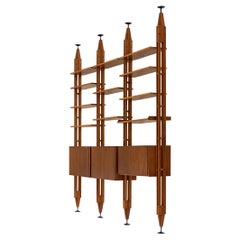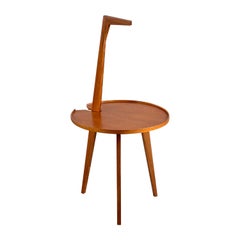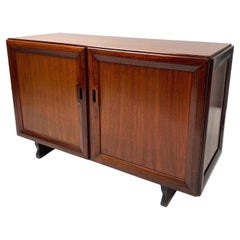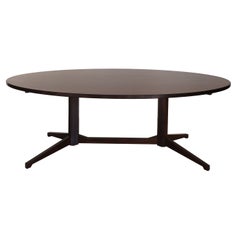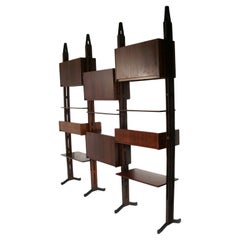Poggi
| Average Sold Price |
| $5,093 |
| Styles |
| Materials |
| Related Creators |
Lb7 bookcase, designed by Franco Albini for Poggi Pavia, Italy
By Poggi, Franco Albini
Located in Piacenza, Italy
Modular bookshelf designed by Franco Albini in 1956 for Poggi Pavia.
An exceptionally flexible bookshelf with various modular options, suitable to be placed against a wall or used as...
Category
1950s Italian Mid-Century Modern Vintage Poggi
Materials
Wood
$32,433
H 111.82 in W 102.37 in D 13.78 in
Franco Albini Cicognino Side Table in Wood by Poggi Pavia, 1970s Italy
By Poggi, Franco Albini
Located in Brescia, Brescia
This exquisite Cicognino side table, designed by Franco Albini and produced by Poggi Pavia in the 1970s, is a timeless piece of Italian design. Crafted from high-quality wood, this t...
Category
1970s Italian Mid-Century Modern Vintage Poggi
Materials
Wood, Teak
$3,075 Sale Price
42% Off
H 31.5 in Dm 15.75 in
Midcentury LB7 modular bookcase designed by Franco Albini for Poggi, Italy 1957
By Franco Albini, Poggi
Located in Piacenza, Italy
Modular bookcase model LB7 designed by Franco Albini for Poggi.
Marked Poggi Pavia.
An extremely flexible bookcase, with different modular options, suited to being against a wall or...
Category
1950s Italian Mid-Century Modern Vintage Poggi
Materials
Wood
$10,811
H 118.12 in W 35.44 in D 15.75 in
Franco Albini, Mid-Century "MB15" sideboard for Poggi, Italy 1957
By Poggi, Franco Albini
Located in Argelato, BO
Franco Albini, MB15 pair of sideboards for Poggi, Italy, 1957
The MB15 sideboard by Franco Albini shown in the images feature a refined and understated design, typical of the Italia...
Category
1950s Italian Mid-Century Modern Vintage Poggi
Materials
Wood
$5,886 / set
H 30.32 in W 48.04 in D 18.51 in
Franco Albini and Franca Helg for Poggi Italian Walnut Dining Table TL22
By Franco Albini and Franca Helg, Poggi
Located in Reggio Emilia, IT
Italian Mid-Century Modern design dining table designed by Franco Albini and Franca Helg and produced by Poggi Pavia from 1958 with veneered walnut top with elliptical shaped longer ...
Category
1950s Italian Mid-Century Modern Vintage Poggi
Materials
Wood, Walnut
$7,207 Sale Price
20% Off
H 28.94 in W 76.38 in D 44.89 in
Franco Albini Italian Bookcase in Rosewood for Poggi Mid Century circa 1950s
By Franca Helg, Poggi, Franco Albini
Located in Atlanta, GA
Modernist Italian Bookcase, designed by Franco Albini and Franca Helg for Poggi, Italy, circa 1950s. This library is believed to be Model LB7 or LB8 and is comprised of four uprights...
Category
1950s Italian Mid-Century Modern Vintage Poggi
Materials
Metal
$16,550
H 109 in W 103.25 in D 15.75 in
Franco Albini Italian Midcentury Dark Wood Sideboard for Poggi, 1950s
By Poggi, Franco Albini
Located in Reggio Emilia, IT
Italian Mid-Century Modern design credenza sideboard designed by Franco Albini and produced by Poggi Pavia from 1958, four doors with sliding shelves and a pull-out shelf / tray, sol...
Category
1850s Italian Mid-Century Modern Antique Poggi
Materials
Wood
$11,435 Sale Price
20% Off
H 30.32 in W 95.28 in D 18.51 in
Augusto Savini for Pozzi Set of Four 'Pamplona' Dining Chairs in Red Lacquer
By Poggi, Augusto Savini
Located in Waalwijk, NL
Augusto Savini for Pozzi, set of four 'Pamplona' dining chairs, lacquered wood, fabric, aluminum, Italy, 1960s
'Pamplona' armchairs in red lacquered wood and red textured upholster...
Category
1960s Italian Mid-Century Modern Vintage Poggi
Materials
Aluminum
$11,000 / set
H 27.56 in W 22.45 in D 20.67 in
Browse all Furniture from Poggi
Shop NowPoggi Sale Prices
This data represents a recent sample of sales made on 1stDibs during the specified years. All sales are anonymized.
| Sold Date | Sold Price | Category | Material | Creation Year | |||||||||||||||||||||||||||||||||||||||||
|
| $5,093 |
Average sold price of items in the past 12 months |
| $1,742-$12,010 |
| Sold price range of items in the past 12 months |
Creators Similar to Poggi
Poggi furniture for sale on 1stDibs.
Poggi furniture are available for sale on 1stDibs. These distinctive items are frequently made of wood and are designed with extraordinary care. There are many options to choose from in our collection of Poggi furniture, although brown editions of this piece are particularly popular. Many of the original furniture by Poggi were created in the mid-century modern style in italy during the 20th century. If you’re looking for additional options, many customers also consider furniture by Melchiorre Bega, M. Singer & Sons, and Vittorio Nobili. Prices for Poggi furniture can differ depending upon size, time period and other attributes — on 1stDibs, these items begin at $1,100 and can go as high as $38,327, while a piece like these, on average, fetch $9,009.
